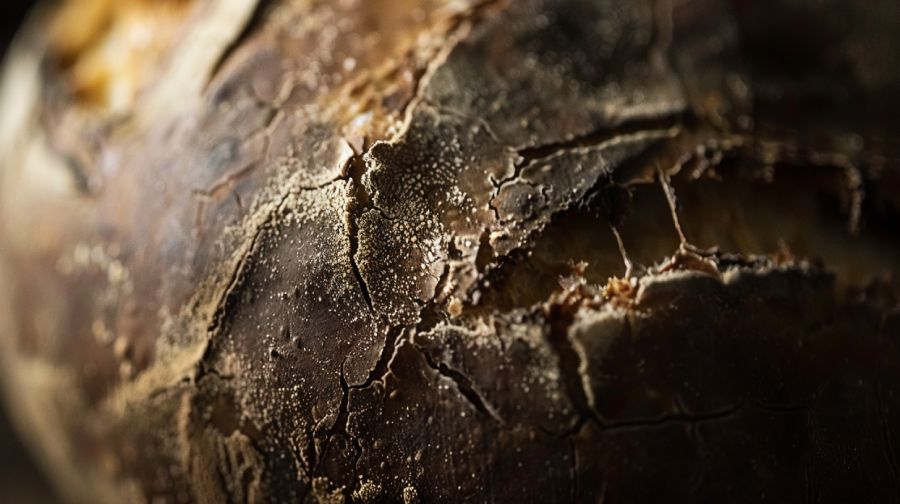Can Sourdough Bread Make You Sick: What You Need to Know to Stay Safe?
Yes, sourdough bread can make you sick under certain conditions. If it’s improperly stored, mold can develop, leading to nausea or digestive issues if consumed.
And, if you have sensitivities to gluten or acidity, sourdough may cause discomfort. Neglecting to maintain your sourdough starter can also increase the risk of harmful contamination.
Always check for signs of spoilage, like unusual smells or visible mold, before consuming. Knowing how to prepare and store your bread properly can prevent health issues while allowing you to enjoy its benefits. More insights are available to guarantee safe sourdough consumption.
Key Takeaways
- Sourdough bread can cause digestive discomfort for those sensitive to gluten or acidity, especially if overeaten or consumed too soon after baking.
- Mold contamination from improper storage or neglecting starter maintenance can lead to serious health risks, causing nausea and digestive upset.
- Moldy sourdough starters may harbor harmful bacteria and toxins, which can worsen respiratory issues for individuals with allergies or asthma.
- Regular feeding and monitoring of sourdough starters are crucial in preventing mold growth and maintaining overall health.
Sourdough Bread Overview
Sourdough bread, characterized by its tangy flavor and unique texture, is created through a fermentation process that harnesses wild yeast and a sourdough starter. This process not only develops the bread’s distinct taste but also fosters the growth of good bacteria, particularly lactic acid bacteria. These microorganisms contribute to the bread’s flavor and play an important role in enhancing its nutritional profile.
The basic ingredients of sourdough bread include flour, water, a sourdough starter, and salt. As these ingredients ferment, they improve the bread’s digestibility and nutrient absorption. Research indicates that sourdough fermentation can lower gluten content, making it potentially more tolerable for some individuals, although it’s important to note that it’s not gluten-free.
Nutritionally, a typical slice of sourdough bread (about 50g) contains approximately 185 calories, along with vital nutrients such as calcium, potassium, magnesium, folate, and niacin. The health benefits you experience from sourdough bread may depend on your individual dietary needs, particularly since it can still trigger reactions in those with celiac disease or gluten intolerance.
Safety and Health Risks
When making sourdough bread, you need to be aware of potential safety and health risks.
Mold contamination can lead to serious respiratory issues, while improper fermentation may cause digestive discomfort.
Mold Contamination Risks
Improper storage of sourdough bread can lead to mold growth, which poses serious health risks, including respiratory issues upon consumption. Mold contamination can occur if you neglect to feed your sourdough starter regularly or use contaminated flour.
Even small amounts of mold, whether on the bread or the starter, can cause illness, so it’s essential to discard any visibly moldy portions immediately.
When you see fuzzy spots, off smells, or unusual color changes, these are signs that your sourdough bread or starter has been compromised. If you detect mold in your sourdough starter, it’s important to understand that you can’t salvage it—you must throw the entire starter away. Mold spores penetrate throughout the mixture, making it unsafe.
To avoid these risks, store your sourdough bread properly in a cool, dry place and always use a good sourdough starter to minimize mold growth.
Prioritizing proper care will help guarantee that your sourdough remains safe and delicious. Remember, what might seem like a minor issue can lead to serious health consequences if mold contamination is ignored.
Digestive Issues Explained
Digestive issues can arise from consuming sourdough bread, particularly for those sensitive to gluten or acidity, as the fermentation process alters its composition. While sourdough is generally safe, overeating or eating it too soon after baking can lead to discomfort due to carbon dioxide release during cooling.
If you have a mild wheat intolerance, you might notice symptoms regardless of the bread type, although some find homemade sourdough more tolerable than commercial options. The fermentation process enhances nutrient absorption, but it can also cause digestive upset in sensitive individuals, especially if the bread is overly sour or not fully cooled.
Underbaked sourdough poses further risks, potentially resulting in gastrointestinal issues, so ensuring thorough baking is essential. While fermented foods like sourdough can support digestive health, specific health conditions require caution. Some individuals may react negatively to the bread’s acidity or gluten content.
As a result, if you have existing digestive issues or sensitivities, it’s wise to monitor your body’s response to sourdough and consult a healthcare professional if necessary. This way, you can enjoy sourdough while minimizing the risk of digestive discomfort.
Proper Starter Maintenance
Maintaining a healthy sourdough starter is essential not only for achieving the desired rise and flavor in your bread but also for ensuring safety and minimizing health risks associated with contamination. Proper maintenance of sourdough starters involves regular feeding, ideally at least once a week. This keeps the yeast active and prevents mold growth, which can lead to serious health issues.
A healthy starter should be bubbly, rise within 4-6 hours after feeding, and emit a pleasant tangy aroma. If you notice any signs of mold, discard the entire starter immediately, as mold spores penetrate throughout the mixture and can’t be safely salvaged.
To minimize contamination risks, always use clean, sterilized containers and utensils when handling your starter. Additionally, maintaining a stable temperature of around 70 degrees Fahrenheit and avoiding excess humidity will keep your starter healthy and reduce spoilage risks.
Digestive Reactions to Sourdough
Consuming sourdough bread can lead to various digestive reactions, ranging from mild discomfort to more severe gastrointestinal issues, depending on individual tolerance and preparation methods. One common issue is yeast overload, which can cause symptoms like diarrhea and abdominal cramps. If you notice a distinct sourdough smell in your feces, it may indicate a reaction to the fermentation process that occurs during sourdough preparation.
Additionally, underbaked sourdough can result in gastrointestinal distress due to incomplete cooking, allowing harmful bacteria to survive. While sourdough’s lower gluten content may benefit some by easing digestion, it’s important to remember that it’s not gluten-free. Individuals with celiac disease or gluten intolerance can still experience negative reactions.
On a positive note, the fermentation process in sourdough acts as a prebiotic, promoting the growth of beneficial gut bacteria. This aspect may contribute to improved digestive health for some individuals, making sourdough a good option for those who can tolerate it.
Ultimately, understanding your body’s reactions to sourdough is essential for enjoying its benefits while minimizing discomfort.
Mold and Contamination Issues

When you notice fuzzy spots on your sourdough starter, it’s vital to recognize these as signs of mold contamination.
Consuming moldy starter can lead to serious health issues, so understanding how to identify mold presence and the associated risks is essential.
Identifying Mold Presence
Identifying mold presence in sourdough starter requires vigilance, as visible signs like green, black, or white fuzzy spots indicate contamination that necessitates immediate disposal.
Mold can develop due to contaminated flour, neglect in feeding the starter, or using unclean tools and containers. Therefore, maintaining proper hygiene and care is vital.
In addition to the visible signs, pay attention to off smells; sour or rotten odors often suggest spoilage.
A liquid layer on top, known as hooch, may appear without indicating mold but could signal neglect in your starter’s care.
Regular monitoring for unusual colors or textures is fundamental to guarantee your starter remains healthy.
Health Risks Involved
Moldy sourdough starter can lead to serious health risks, as the presence of harmful bacteria and toxins often results from improper care and contamination. If you encounter visible signs of mold, such as green, black, or white fuzzy spots, it’s vital to discard the starter immediately to avoid potential health hazards.
Here are three key risks associated with moldy sourdough starter:
- Respiratory Issues: Inhaling mold spores can cause respiratory problems, especially for those with allergies or asthma.
- Foodborne Illness: Consuming bread made from contaminated starter can introduce harmful bacteria, leading to gastrointestinal issues and infections.
- Toxin Exposure: Some molds produce mycotoxins, which can result in serious health complications, including neurological problems and immune system suppression.
Regular maintenance of your sourdough starter is essential to mitigate these risks. Neglecting to feed your starter or using contaminated flour increases the likelihood of harmful bacteria growth and mold development.
Always prioritize cleanliness and proper storage techniques to guarantee the safety of your sourdough products.
Prevention Strategies Explained
Preventing mold and contamination in sourdough starter requires diligent attention to cleanliness and regular maintenance practices.
To start, always use clean, sterilized containers and utensils when handling your sourdough starter. This minimizes contamination risks and helps maintain a healthy environment for fermentation.
Feed your sourdough starter at least once a week. Regular feedings keep the starter robust and help prevent the development of harmful molds and bacteria that can make you sick. Make sure to store the starter in a cool, dark place, away from excess humidity, as this greatly reduces the chances of mold contamination.
Monitoring for spoilage is essential. Look for visible mold, off smells, or unusual colors, as these are indicators that your starter may be compromised. If you do spot mold growth, discard the entire sourdough starter immediately. Mold spores can penetrate throughout the mixture and can’t be safely salvaged.
Identifying Moldy Starter
When evaluating your sourdough starter, look for visible signs of contamination, such as fuzzy spots that can be green, black, or white, which indicate mold presence and necessitate immediate disposal. Mold can compromise the safety of your starter, so it’s essential to act quickly.
To effectively identify a moldy starter, keep an eye out for these three warning signs:
- Fuzzy Spots: Any green, black, or white fuzzy appearance means mold is present and the starter should be discarded.
- Off Smell: A sour or rotten odor signals spoilage, indicating that the starter is no longer safe to use.
- Unusual Liquid Layer: While hooch is typical, a slimy texture or strange colors can indicate contamination.
Preventing Mold Growth
Maintaining a clean environment and proper care of your sourdough starter greatly reduces the chances of mold growth. To effectively manage your starter, consider the following practices:
| Practice | Explanation |
|---|---|
| Use Clean Utensils | Guarantees no contaminants enter your starter. |
| Sterilize Storage Jars | Reduces the risk of introducing mold spores. |
| Regular Feedings | Feed your starter at least once a week to keep it active. |
| Store in a Cool, Dark Place | Minimizes moisture and humidity exposure. |
| Monitor Your Environment | Keep the starter away from damp areas to prevent mold growth. |
Nutritional Benefits of Sourdough
While keeping your sourdough starter mold-free is important, understanding the nutritional benefits of sourdough bread can enhance your dietary choices and overall health.
Incorporating sourdough into your diet is a good idea for several reasons:
- Nutrient-Rich: Sourdough contains essential nutrients such as calcium, potassium, magnesium, folate, and niacin. These are vital for various bodily functions, supporting everything from bone health to energy metabolism.
- Enhanced Absorption: The fermentation process increases the bioavailability of nutrients, making them easier for your body to absorb. This means that when you consume sourdough, you’re likely getting more nutritional benefits compared to conventional bread.
- Gut Health: Sourdough acts as a prebiotic, promoting beneficial gut bacteria. This can support your overall digestive health, making it easier for you to maintain a balanced gut microbiome.
Additionally, its lower gluten content may ease digestion for some individuals, as the fermentation process helps break down gluten.
Baking Process and Best Practices
The baking process of sourdough bread is fundamental for guaranteeing safety and enhancing its nutritional profile, as high temperatures effectively eliminate harmful microorganisms. To make certain your bread is safe, always bake it at temperatures above 190°F (88°C). This not only kills bacteria but also contributes to the bread’s overall flavor and texture.
After baking, allow your sourdough to cool for at least one hour. This cooling period enhances digestibility and flavor development, making the bread more enjoyable. If you’re sensitive to certain ingredients, consider letting the bread rest for 24-48 hours after baking. This resting time can improve texture and reduce the likelihood of digestive discomfort.
When making sourdough, monitor your proofing times and use an appropriate amount of starter. Overly sour bread may cause discomfort for some, so adjusting these factors is essential.
Community Experiences and Insights
Community members frequently share their experiences with sourdough bread, revealing a range of digestive issues that some attribute to factors like yeast overload or improper baking techniques. Many report symptoms such as sour stomach, diarrhea, or nausea, particularly when consuming bread that hasn’t cooled properly or is underbaked.
Here are three key insights from the community:
- Fermentation Time: Proper fermentation is vital. People emphasize that rushing the process can lead to gastrointestinal discomfort.
- Cooling Period: Allowing sourdough to cool adequately before slicing helps prevent digestive issues. Freshly baked bread can be harder on the stomach.
- Starter Health: Monitoring your sourdough starter’s health is essential. A bad sourdough starter can introduce unwanted flavors and potential health risks.
Interestingly, individuals with mild gluten intolerance often find sourdough more digestible, yet some still experience discomfort. This highlights the variability in personal sensitivities and the need for careful observation of how sourdough affects you.
Frequently Asked Questions
Can Sourdough Bread Upset Your Stomach?
Yes, sourdough bread can upset your stomach, especially if you consume it in excess or immediately after baking. Its fermentation process produces lactic acid, which may cause discomfort for those with sensitivities or intolerances.
Who Should Avoid Sourdough Bread?
Sourdough bread is a good choice for those sensitive to gluten. It can also trigger uncomfortable or even severe reactions in those with celiac disease, wheat allergies, or interstitial cystitis.
What Are the Signs of Bad Sourdough?
It would be best if you watched for visible mold, off smells, and unusual color changes in sourdough. A slimy texture or excessive separation of liquid indicates spoilage. If you notice these signs, discard the sourdough immediately.
Can You Have Intolerance to Sourdough Bread?
Like a hidden storm, sourdough bread can trigger intolerance in some individuals. Due to mild wheat sensitivity, you may experience bloating or gas, even though its fermentation process often makes gluten more tolerable for others.
Enjoying Sourdough Safely: Best Practices for Health-Conscious Baking
In summary, while sourdough bread boasts numerous health benefits, it can pose risks if not handled properly.
You might be surprised to learn that a seemingly innocent loaf could harbor harmful mold or provoke digestive issues.
You can enjoy this delicious bread without worry by staying vigilant about your starter’s condition and adhering to proper baking practices.
Remember, the more you know about your food, the safer and more satisfying your culinary adventures will be.







